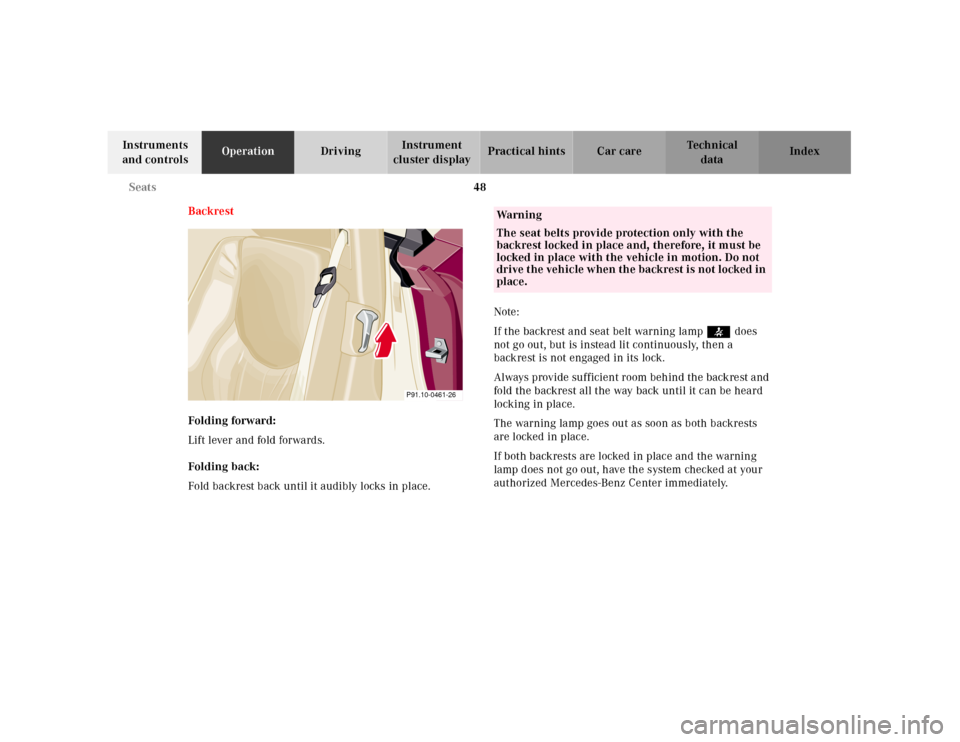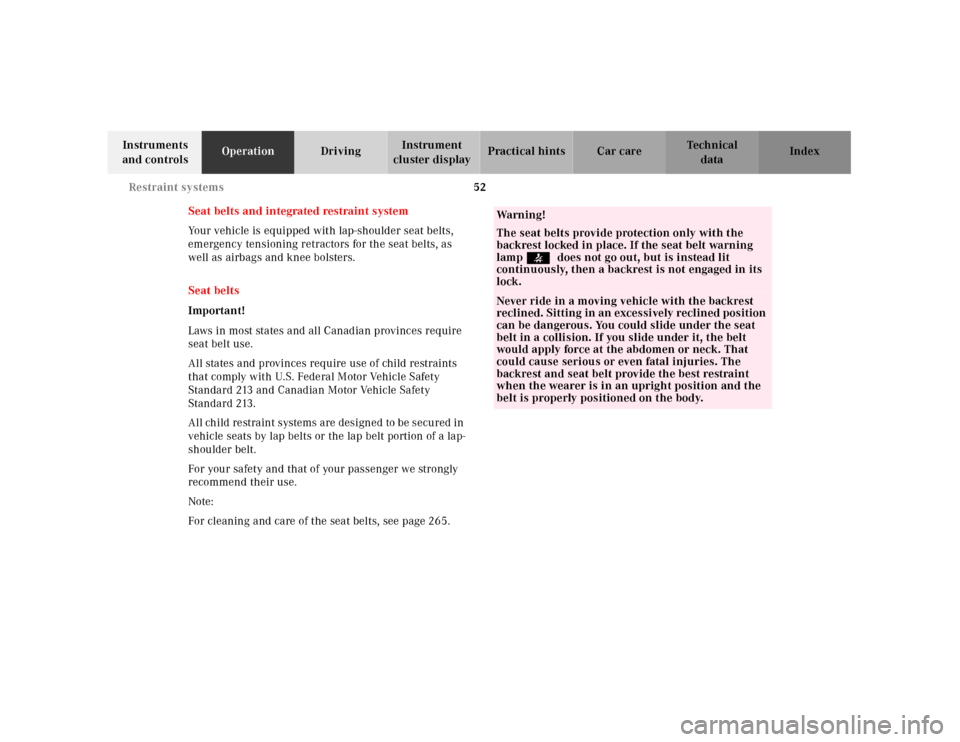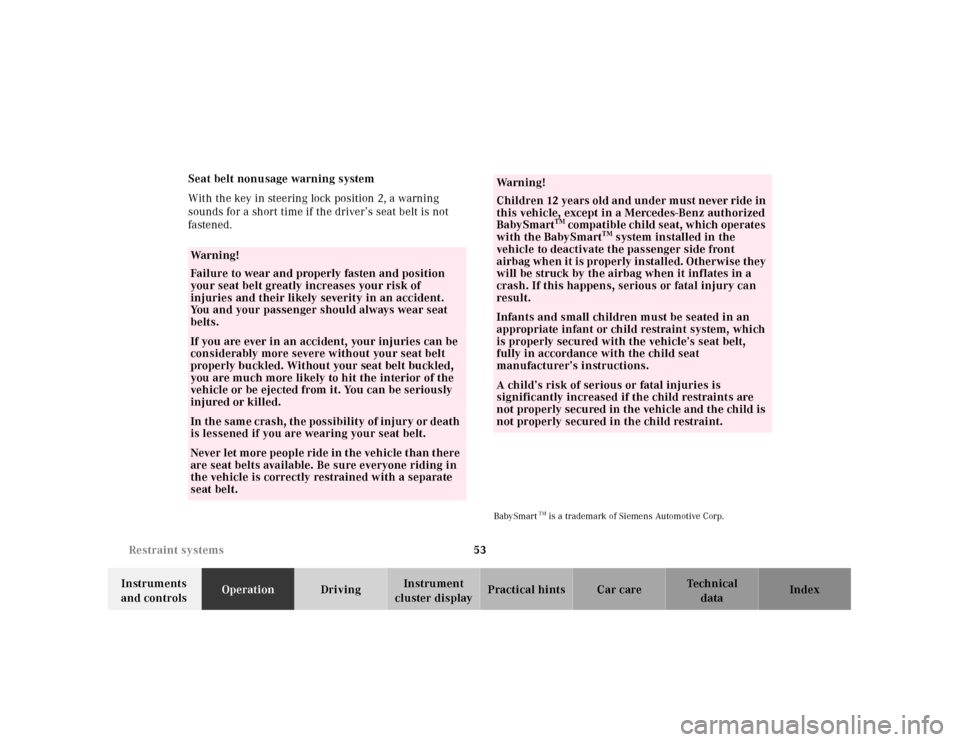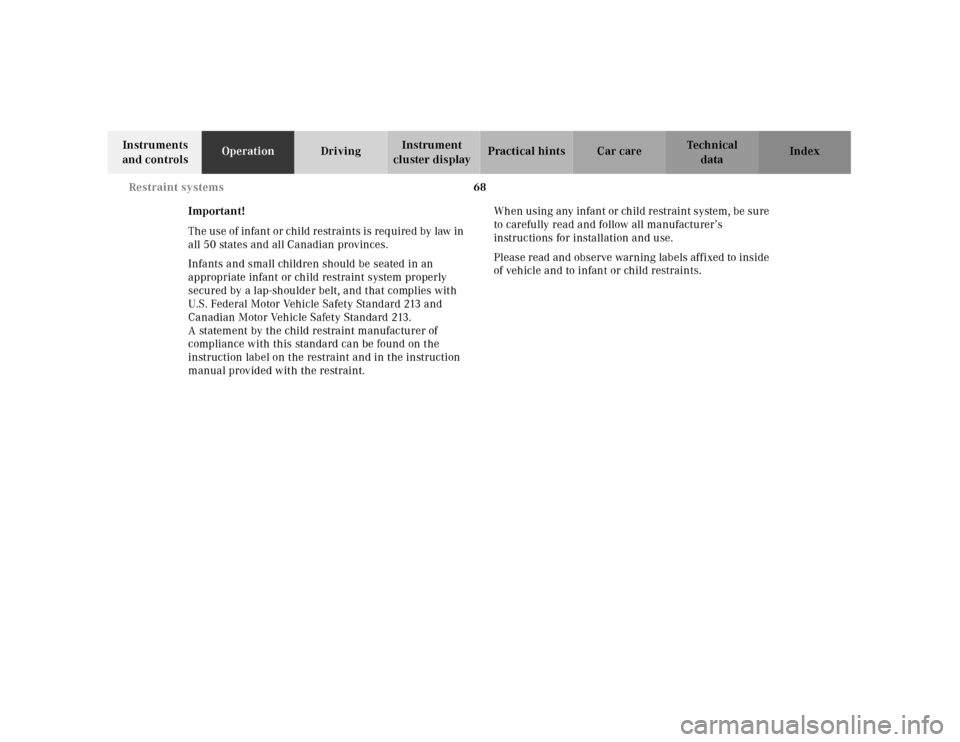2000 MERCEDES-BENZ SL600 warning
[x] Cancel search: warningPage 31 of 297

27 Contents – Operation
Technical
data Instruments
and controlsOperationDrivingInstrument
cluster displayPractical hints Car care Index Trip odometer ............................... 79
Clock .............................................. 79
Tachometer .................................... 79
Flexible service system (FSS) ........ 80
Engine oil level indicator in
odometer display field ................ 82
Fuel consumption gauge ................. 83
Engine oil temperature gauge ........ 83
Engine oil consumption .................. 83
Exterior lamp switch ....................... 84
Standing lamps ............................. 85
Night security illumination ........ 85
Combination switch ........................ 86
Blocked windshield wiper .......... 88
Windshield wiper smears ........... 88
Windshield and headlamp
washer fluid mixing ratio ........... 88
Hazard warning flasher switch ..... 89
Automatic climate control .............. 90
Display and controls .................... 92
Basic setting - automatic mode .. 93
Economy ........................................ 93
Special settings ............................ 94Audio and telephone, operation .... 98
Power windows ............................... 116
Express opening of
door windows .............................. 117
Synchronizing power
windows ....................................... 117
Roll bar ............................................. 118
Interior lighting ............................. 120
Interior lamps ............................. 120
Reading lamps ............................ 120
Entrance lamps in footwells,
exit lamps in doors .................... 120
Sunshade, manual ..........................121
Power sunshade ............................. 122
Sun visors ....................................... 123
Illuminated vanity mirror ............ 123
Interior ............................................ 124
Storage compartment
(eyeglasses compartment)
in the dashboard ...................... 124
Interior central
locking system ........................... 125
Integration with vehicle
central locking system .............. 126Separate locking of storage
compartments ............................. 126
Armrest ........................................... 127
Console storage
compartments ............................ 127
Cup holder ...................................... 128
Parcel net in
passenger footwell .................... 128
Door pockets ................................... 129
Rear storage compartment ........... 129
Ashtray with lighter ...................... 130
Lighter ............................................. 131
Telephone, general ........................ 132
Garage door opener ....................... 133
Hardtop or panorama roof ............ 137
Removing hardtop ...................... 137
Attaching hardtop ...................... 140
Soft top ............................................ 143
Lowering soft top ........................ 144
Raising soft top ........................... 145
Wind screen .................................... 148
Antenna ........................................... 151
Page 52 of 297

48 Seats
Technical
data Instruments
and controlsOperationDrivingInstrument
cluster displayPractical hints Car care Index
Backrest
Folding forward:
Lift lever and fold forwards.
Folding back:
Fold backrest back until it audibly locks in place.Note:
If the backrest and seat belt warning lamp< does
not go out, but is instead lit continuously, then a
backrest is not engaged in its lock.
Always provide sufficient room behind the backrest and
fold the backrest all the way back until it can be heard
locking in place.
The warning lamp goes out as soon as both backrests
are locked in place.
If both backrests are locked in place and the warning
lamp does not go out, have the system checked at your
authorized Mercedes-Benz Center immediately.
P91.10-0461-26
Wa r n i n g
The seat belts provide protection only with the
backrest locked in place and, therefore, it must be
locked in place with the vehicle in motion. Do not
drive the vehicle when the backrest is not locked in
place.
Page 56 of 297

52 Restraint systems
Technical
data Instruments
and controlsOperationDrivingInstrument
cluster displayPractical hints Car care Index
Seat belts and integrated restraint system
Your vehicle is equipped with lap-shoulder seat belts,
emergency tensioning retractors for the seat belts, as
well as airbags and knee bolsters.
Seat belts
Important!
Laws in most states and all Canadian provinces require
seat belt use.
All states and provinces require use of child restraints
that comply with U.S. Federal Motor Vehicle Safety
Standard 213 and Canadian Motor Vehicle Safety
Standard 213.
All child restraint systems are designed to be secured in
vehicle seats by lap belts or the lap belt portion of a lap-
shoulder belt.
For your safety and that of your passenger we strongly
recommend their use.
Note:
For cleaning and care of the seat belts, see page 265.
Wa r n i n g !
The seat belts provide protection only with the
backrest locked in place. If the seat belt warning
lamp< does not go out, but is instead lit
continuously, then a backrest is not engaged in its
lock.Never ride in a moving vehicle with the backrest
reclined. Sitting in an excessi vely reclined position
can be dangerous. You could slide under the seat
belt in a collision. If you slide under it, the belt
would apply force at the abdomen or neck. That
could cause serious or even fatal injuries. The
backrest and seat belt provide the best restraint
when the wearer is in an upright position and the
belt is properly positioned on the body.
Page 57 of 297

53 Restraint systems
Technical
data Instruments
and controlsOperationDrivingInstrument
cluster displayPractical hints Car care Index Seat belt nonusage warning system
With the key in steering lock position 2, a warning
sounds for a short time if the driver’s seat belt is not
fastened.
BabySmart
TM is a trademark of Siemens Automotive Corp.
Wa r n i n g !
Failure to wear and properly fasten and position
your seat belt greatly increases your risk of
injuries and their likely severity in an accident.
You and your passenger should always wear seat
belts.If you are ever in an accident, your injuries can be
considerably more severe without your seat belt
properly buckled. Without your seat belt buckled,
you are much more likely to hit the interior of the
vehicle or be ejected from it. You can be seriously
injured or killed.In th e sam e c rash, th e possibility of injury or death
is lessened if you are wearing your seat belt.Never let more people ride in the vehicle than there
are seat belts available. Be sure everyone riding in
the vehicle is correctly restrained with a separate
seat belt.
Wa r n i n g !
Children 12 years old and under must never ride in
this vehicle, except in a Mercedes-Benz authorized
BabySmart
TM compatible child seat, which operates
with the BabySmart
TM system installed in the
vehicle to deactivate the passenger side front
airbag wh en it is properly installed. Otherwise they
will be struck by the airbag when it inflates in a
crash. If this happens, serious or fatal injury can
result.
Infants and small children must be seated in an
appropriate infant or child restraint system, which
is properly secured with the vehicle’s seat belt,
fully in accordance with the child seat
manufacturer’s instructions.A child’s risk of serious or fatal injuries is
significantly increased if the child restraints are
not properly secured in the vehicle and the child is
not properly secured in the child restraint.
Page 72 of 297

68 Restraint systems
Technical
data Instruments
and controlsOperationDrivingInstrument
cluster displayPractical hints Car care Index
Important!
Th e use of infant or child restraints is req uire d by law in
all 50 states and all Canadian provinces.
Infants and small children should be seated in an
appropriate infant or child restraint system properly
secured by a lap-shoulder belt, and that complies with
U.S. Federal Motor Vehicle Safety Standard 213 and
Canadian Motor Vehicle Safety Standard 213.
A statement by the child restraint manufacturer of
compliance with this standard can be found on the
instruction label on the restraint and in the instruction
manual provided with the restraint.Wh en using any infant or ch il d restraint system, be su re
to carefully read and follow all manufacturer’s
instructions for installation and use.
Please read and observe warning labels affixed to inside
of vehicle and to infant or child restraints.
Page 79 of 297

75 Instrument cluster
Technical
data Instruments
and controlsOperationDrivingInstrument
cluster displayPractical hints Car care Index 1Fuel gauge with reserve and fuel cap placement
warning lamp (yellow), see page 207
2Coolant temperature gauge, see page 78
3Fuel consumption gauge, see page 83
4Engine oil temperature gauge, see page 83
5Left turn signal indicator lamp (green),
see combination switch on page 86
6K nob for intensity of instrum ent l amps, see pa ge 77,
for resetting trip odometer, see page 79 and
for calling up FSS indicator, see page 80
7Speedometer8EPS warning lamp (yellow), see page 207
9Odometer display field, see page 82
10Main/trip odometer, see page 79
or FSS indicator, see page 80
or engine oil level indicator, see page 82
11Outside temperature indicator, see page 78
12Right turn signal indicator lamp (green),
see combination switch on page 86
13Tachometer, see page 79
14Knob for setting clock, see page 79
15Clock, see page 79
Page 80 of 297

76 Instrument cluster
Technical
data Instruments
and controlsOperationDrivingInstrument
cluster displayPractical hints Car care Index
Indicator lamps in the instrument cluster
Fuel reserve and fuel cap placement
warning, see page 207
High beam, see page 86
Battery not being charged properly,
see page 211
Low windshield and headlamp washer
system fluid level see page 210
Coolant level low, see page 209
Engine oil level low, see page 210
Exterior lamp failure indicator lamp,
see page 211
Roll bar warning lamp, see page 212
ESP warning lamp. Adjust driving to road
condition, see page 207
ADS indicator lamp, see page 212BAS/ESP malfunction, see page 207
ABS malfunction, see page 208
Brake pads worn down, see page 205
Brake fluid low (except Canada)
Parking brake engaged, see page 204
Brake fluid low (Canada only)
Parking brake engaged, see page 204
SRS malfunction, see page 206
Fasten seat belt, see page 206
If the lamp comes on when the engine is
running, it indicates a malfunction of the
fuel management system or the emission
control system, or the fuel cap is not closed
tight. In all cases, we recommend that you
have the malfunction checked as soon as
possible, see page 204.
ABS
Page 82 of 297

78 Instrument cluster
Technical
data Instruments
and controlsOperationDrivingInstrument
cluster displayPractical hints Car care Index
Coolant temperature gauge
During severe operating conditions and stop-and-go city
traf f ic, th e coola nt tempera ture may rise close to th e red
marking.
The engine should not be operated with the coolant
temperature in the red zone. Doing so may cause
serious engine damage which is not covered by the
Mercedes-Benz Limited Warranty.Outside temperature indicator
The temperature sensor is located in the front bumper
area. Due to its location, the sensor can be affected by
road or engine heat during idling or slow driving. This
means that the accuracy of the displayed temperature
can only be verified by comparison to a thermometer
placed next to the sensor, not by comparison to external
displays (e.g. bank signs etc.).
Adaptation to ambient temperature takes place in steps
and depends on the prevailing driving conditions (stop-
and-go or moderate, constant driving) and amount of
temperature change.
Wa r n i n g !
• Driving when your engine is badly overheated
can cause some fluids which may have leaked
into the engine compartment to catch fire. You
could be seriously burned.• Steam from an overheated engine can cause
serious burns and can occur just by opening
the engine hood. Stay away from the engine if
you see or hear steam coming from it.Turn off the engine, get out of the vehicle and do
not stand near the vehicle until it cools down.
Wa r n i n g !
The outside temperature indicator is not designed
to serve as an Ice-Warning Device and is therefore
unsuitable for that purpose. Indicated
temperatures just above the freezing point do not
guarantee that the road surface is free of ice.